IN THIS ISSUE
- The scoop on spittlebugs
- A fish full of surprises
- Alligator Creek's rare bees
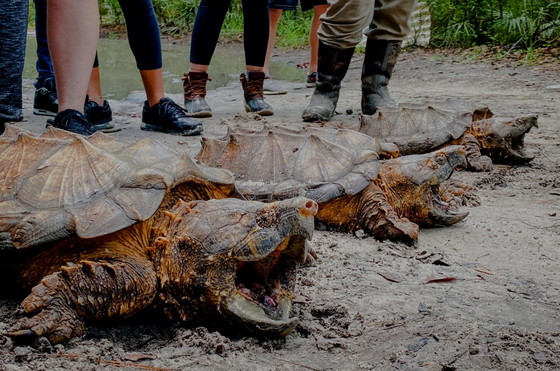 A trio of Suwanee alligator snappers; below, VSU class with turtle haul (Chris Coppola/USFWS)
As part of a summer herpetology course at Valdosta State University, Dr. Adam Safer’s class helped biologists check turtle traps on the Alapaha River in June.
The catch-and-release results were impressive: yellowbelly sliders, loggerhead musk turtles, a large female spiny softshell and no fewer than three Suwannee alligator snapping turtles, the targeted species.
Working with Chris Coppola of the U.S. Fish and Wildlife Service, consultant Dirk Stevenson and turtle conservationist Greg Brashear, the students gathered data on the Suwannee snappers for efforts to assess the species’ status. Those checks included determining the sex of the turtles – all caught in the same trap – weighing them (the largest was nearly 40 pounds), measuring the upper and lower shell lengths, and marking each snapper with a passive integrated transponder.
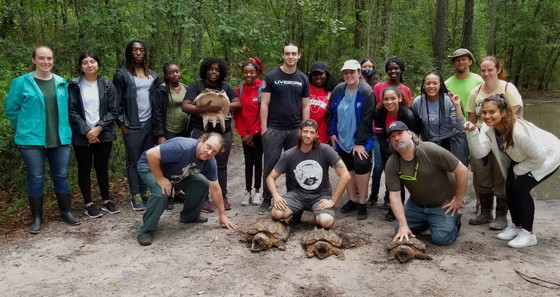
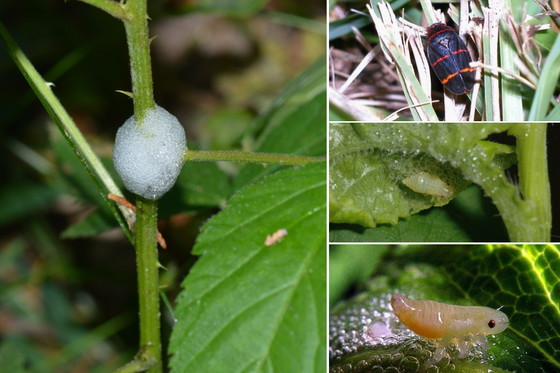 Spittlebug home (left-right), froghopper adult and nymphs (Terry Johnson, Clint Waltz/UGA, UMinnesota Extension)
By TERRY W. JOHNSON
I don't know about you, but as I grow older I sometimes come across things that transport me back in time. Spotting, of all things, a spittlebug lair prompted my latest trip down memory lane.
Spittlebugs will never be considered among Mother Nature's most attractive creations. Adult spittlebugs are called froghoppers because they can leap up to 100 times their body length.
While the nymphs cannot jump, like the adults they are named for a distinct feature. Dubbed spittlebugs, they live in what looks like globs of saliva clumped on plants. …
Read Terry’s column to learn about these insects, including what the spittle does.
Terry W. Johnson is a retired DNR program manager and executive director of TERN, the Wildlife Conservation Section’s friends group. Check out past columns, his Backyard Wildlife Connection blog and his book “A Journey of Discovery: Monroe County Outdoors.” Permission is required to reprint his columns.
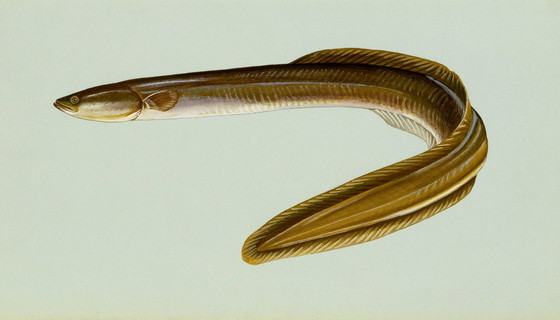 American eel (USFWS)
Author and newspaper columnist Charles Seabrook remembers well his first encounter with an American eel.
As a teen, he and two friends were fishing by boat in South Carolina’s Edisto River when one of the friends had a bite. He started to reel but the rod bent double and the fish wouldn’t budge. All tried but no one could reel it in.
“My buddy was about ready to give up and cut the line,” Seabrook writes, “but the line suddenly slackened and he pulled a big, wriggling eel into the boat. Then we almost turned the boat over trying to get away from the thing.”
When it comes to the serpentine American eel, surprises are routine.
First, it’s a fish, and one that spend most of its adult life in fresh- and brackish waters before returning to the sea to spawn, a complex cycle called catadromy.
To be clear, eels should not be confused with lampreys, says DNR aquatic biologist Paula Marcinek. “Taxonomically, lampreys and eels are in different families, with lampreys in Petromyzontidae, which are jawless fishes, and American eels in Anguillidae, or freshwater eels.” (Nor are American eels closely related to electric eels, which are in the family Gymnotidae and aren't even eels.)
Yet, although the American eel is the continent's only native eel and the source of a once-robust commercial fishery, exactly where the species spawns is a mystery. Adults reaching sexual maturity – about five to 25 years – migrate from lakes, rivers and streams to spawn somewhere in the Sargasso Sea, a massive swath of the Atlantic Ocean between Bermuda and the Bahamas.
The process that follows hatching is fascinating. Carried by ocean currents moving clockwise, embryos grow from larvae to transparent-bodied "glass" eels, and then through the stair-step stages of elver, yellow and silver eels as they mature in estuarine and fresh waters. The journey can top 3,000 miles and take years.
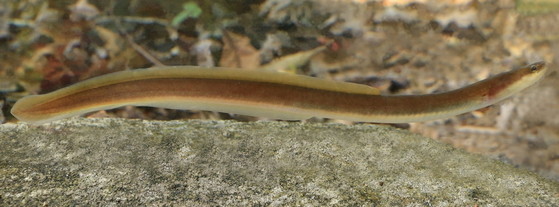 Female eel in the South Fork Edisto River drainage (Alan Cressler/USGS)
American eels not only travel far, they can live long and grow large – topping 4 feet and 16 pounds. The oldest eel on record reached a silver-skinned 43 years.
What’s not surprising, considering water quality issues, dams blocking their way and people catching them for food and bait, is that these eels are rated an at-risk species by some. Reviews by the U.S. Fish and Wildlife Service have found no need to protect Atlantic Coast populations under the Endangered Species Act. But Canada has banned harvest, and the U.S. Great Lakes Fishery Commission has deemed the decline there “severe” and urged a coordinated response by governments and tribes.
In Georgia, DNR’s Coastal Resources Division surveys yellow-stage eels each year in coastal waters and regulates commercial fishing for eels. DNR Wildlife Resources staff are mapping occurrences as part of wider aquatic conservation efforts.
That said, American eels are secretive and most active at night, when they gobble up worms, crayfish, small fish and other tidbits (watch them feed).
Because of their cryptic nature and low profile, don't be shocked if you're – well – surprised if you see or catch one in Georgia.
EEL INSIGHTS
- Slippery as an eel? Indeed. Eels are slimy because of mucous produced by glands under their scales. The slick coating helps control water allowed in and out of an eel's body and makes the fish more streamlined for swimming.
- RadioLab's "Silky Love" episode is an earthy chat about eel reproduction.
- Eel, it's what's for what for supper; at least it is in Leonardo da Vinci's Last Supper painting. The Gospels don't mention Christ and his disciples eating grilled eel, but Renaissance painters weren't fussy about historical accuracy.
Top
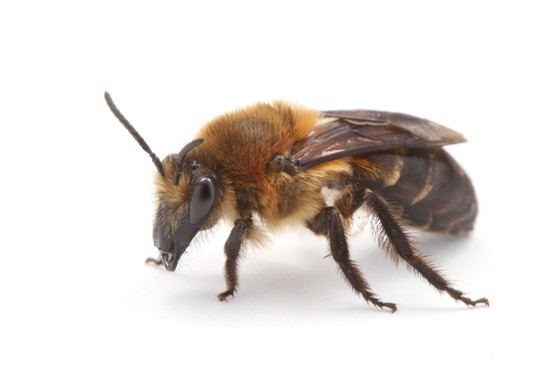 Southeastern sandhill cellophane bee (Dave Almquist/Florida Natural Areas Inventory)
By DIRK STEVENSON
Late last winter, South Georgia State College’s Frankie Snow and I were surveying for invertebrates on Alligator Creek Wildlife Management Area when we spotted a cluster of miniature sand mounds along an old woods road.
The mounds were actually the spoil from small burrows that signaled the presence of an uncommon, little known and very interesting insect, the Southeastern sandhill cellophane bee.
Colletes ultravalidus was first described five years ago from specimens collected in north and west Florida and from a single specimen found in 1997 in Georgia’s Brantley County. Alligator Creek near Lumber City is only the second known site for the species in Georgia.
Members of the genus Colletes line the cells of their nests with a waterproof material that, when dry, resembles clear plastic. Thus, the name cellophane bees. …
Explore the sandhill cellophane bee in this blog post by Dirk Stevenson, a naturalist and environmental consultant.
Initial results indicate that DNR’s Buford and Summerville trout hatcheries tested positive for whirling disease and infectious hematopoietic necrosis virus. While not harmful to humans, the two diseases can cause high trout mortalities in hatchery systems and in the wild. This is the first time either has been found in Georgia. There are no known therapeutic treatments to eliminate the pathogens.
Fisheries Chief Scott Robinson of the DNR Wildlife Resources Division said the agency has temporarily suspended its trout-stocking program and is collecting more trout samples for analysis, investigating the source of both pathogens and identifying disinfectant methodologies to treat the two hatcheries.
Learn more, including what to do if you catch a trout you think might be affected.
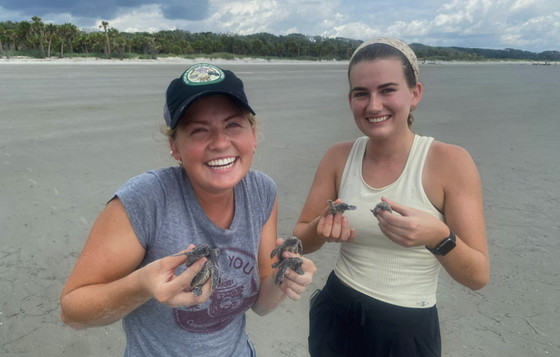 Sea turtle techs show some of the loggerhead hatchlings on St. Catherines Island (DNR)
More than 66,000 sea turtle hatchlings have scrambled for the surf so far this summer on the Georgia coast. And there are more to come, although the nest total – currently at 2,476, almost all of which are loggerheads – likely won’t grow.
Coronavirus concerns had already bumped DNR’s Youth Birding Competition from spring to September, but with the delta variant surging coordinators decided to make the 2021 birdathon virtual. The revised event will be held Sept. 24-Oct. 3, with winners announced online Oct. 5. Also going virtual: the Upper Coosa Conservation Summit (register by Oct. 18).
Whatever disease was killing birds in some Mid-Atlantic and Southeastern states has not been documented in Georgia. DNR biologist Todd Schneider said no Georgia birds checked by the Southeastern Cooperative Wildlife Disease Study have tested positive for the mystery illness (“Keeping watch,” July), and as reports of sick songbirds wane, hard-hit states have started lifting bird-feeding cautions.
 Southeastern Raptor Center volunteer Valerie Castanza releases the eagle at West Point. (Auburn University)
A young bald eagle rehabilitated by Auburn University’s Southeastern Raptor Center was returned to the wild at West Point Lake last week. The eagle was found in southeast Georgia this spring, weak, underweight and carrying internal parasites.
The theft of a St. Simons Island sign explaining the importance of Gould’s Inlet and Georgia barrier islands for shorebirds has spurred calls for tips and hopefully the sign’s return. A Facebook post by Manomet biologist Abby Sterling notes that the weather-proof sign was funded by Coastal Georgia Audubon and the DNR Wildlife Viewing Grants Program, and there’s no money for a new one. (Donations toward a new sign can be made online: Check "WHSRN sign replacement.")
Quick hits:
- Adding to this year’s count of North Atlantic right whale calves, an 18th calf was first spotted in June off the coast of Nova Scotia.
- The State Botanical Garden of Georgia and U.S. Forest Service want your help with an iNaturalist project documenting native grasses and wildflowers as pollinator habitats on the Chattahoochee-Oconee National Forests.
- Teachers and students can celebrate wildlife through art by participating in the 32nd annual Give Wildlife a Chance Poster Contest.
- DNR, UGA and U.S. Fish and Wildlife Service staff mist-netting for bats on the Chattahoochee National Forest caught and released an eastern small-footed bat, a species not caught in Georgia since 2017.
- Gov. Brian Kemp proclaimed September as the month to highlight native plants and the key roles they fill for birds and other wildlife (plant sales).
- DNR’s Coastal Resources Division has updated the popular Marine Fishes of Georgia website.
- Your trash can be a bear’s snack: Securing garbage in areas where bears live is BearWise.
 DNR's Linda May in Georgia Magazine; Daniel Sollenberger at Fernbank (DNR)
Names in the news: The cover of this month's Georgia Magazine features DNR Wildlife Conservation Section outreach coordinator Linda May – red-tailed hawk on her arm – for an article about rehabilitating raptors. May also represented DNR with senior wildlife biologist Daniel Sollenberger at Fernbank’s Reptile Day. Lane Green, former executive director of the Red Hills conservation organization Tall Timbers, died at age 74 on Aug. 15. For interesting and thoughtful views on nature, check out The Nerdy Naturalist blog written by Ethan J. Hatchett, former member of a top Youth Birding Competition team called the Chaotic Kestrels. Ogeechee Technical College in Statesboro named DNR wildlife technician Caleb Mills, who works at Evans County Public Fishing Area, the school's 2021 Outstanding Alumni. Chris Bertrand is the new Satilla Riverkeeper and executive director.
WHAT YOU MISSED ...
In the previous Georgia Wild:
- On high alert for bird illness
- Fins, fur and feathers in Paradise
- Mississippi kites in the backyard
Top
 "MythBusters: Wildlife Edition" tackles do snakes chase people, does Georgia have black panthers and are coyotes the top predator of wild turkeys? DNR
(audio) "Banking rare seeds for a wild future," Georgia Public Broadcasting
"North Georgia bear surveys," DNR
(audio) "Hidden gems in Georgia state parks," Atlanta Real Estate Forum Podcast
(audio) "American Chestnut Foundation," Atlas Obscura Podcast
Coastal Resources Division sinks sailboat at Artificial Reef KTK, DNR
(+audio) "Researchers study early lives of mussels, riding around on fish," WABE-FM (91.7, Atlanta)
"Golden Ray's largest oil discharge delays removal of ship," The Atlanta Journal-Constitution. Also: "Section 6 rises higher, likely oil source plugged," The Brunswick News. Updates: St. Simons Sound Incident Response.
"DNR youth birding competition goes virtual," Yahoo!News (via The Albany Herald)
"Rattlers change rattle frequency based on threats," CNN. Study in Current Biology.
"Jekyll conservation leaders call for more consensus on dredging proposal," The Brunswick News
(+video) "Predator lizard threatens S.C. environment," The State (Columbia, S.C.). Also: "S.C. DNR seeks information on tegus," WSPA-TV (Ch. 7, Spartanburg, S.C.). Related: "Tegu threaten Fla. wildlife," WPTV-TV (Ch. 5, West Palm Beach, Fla.)
"Spaceport: Last stop on way to cosmos? No thanks," The New York Times
"Bill would steer environmental fine revenue to conservation," The Wall Street Journal
"Oceana: 90 percent of vessels speeding in areas meant to protect right whales," The Post and Courier (Charleston, S.C.). Related: Savannah Morning News.
"With lobster-gear whale rules pending, feds turn to other fisheries," Maine Public Radio
"Are songbirds in Georgia dying from unknown disease?" WXIA-TV (Ch. 11, Atlanta). Also: WSB-TV (Ch. 2, Atlanta).
"Discover joys of birdwatching along Georgia's coast," Savannah Magazine
"Poster contest turns attention to nature's engineers," All On Georgia
"Ceylon wilderness a haven for longleaf, tortoises, tranquility," SaportaReport
"Imagination, Skittles help boy, 5, conquer Appalachian Trail," AP
"Oregon success story fuels calls for prescribed burns," The Guardian
"Scientists blame sea snake attacks on sex drive," The New York Times
"Firearm industry surpasses $14B for conservation," National Shooting Sports Foundation
"Park Service to support Gullah Geechee corridor project," Coastal Review Online
"Unlocking the secrets of ‘invisible’ animals," Atlas Obscura
CREDITS
Masthead: Southeastern sandhill cellophane bee (Dave Almquist/Florida Natural Areas Inventory)
Top
|